#split PDF documents
Explore tagged Tumblr posts
Text
PDF Expert for Mac: My Indispensable Tool for Document Management
As someone who handles digital documents daily, I’m always looking for tools that simplify and optimize my workflow. After trying various applications, I found the perfect solution in PDF Expert for Mac. This tool has not only boosted my productivity but also transformed how I manage my PDF files. Let me share my experience and the incredible features of PDF Expert. Easy to Use Right from the…

View On WordPress
#best PDF editor#cloud sync#digital signatures#drag and drop PDF#Dropbox integration#easy PDF editing#fast PDF viewer#file organization#Google Drive integration#iCloud integration#intuitive PDF tool#merge PDF files#PDF annotation#PDF document management#PDF Expert for Mac#PDF form filling#productivity tool#review and comment PDF#seamless PDF workflow#split PDF documents
0 notes
Text

Offline PDF Split Tool for Fast Document Splitting
#pdf split tool#split pdf files offline#offline pdf splitter#free pdf split software#easy pdf file splitting#best pdf splitter#split pdf without internet#extract pdf pages#page range pdf splitter#offline pdf document tool
0 notes
Text
Fully forgot I put my google account birthday as today so for like two minutes I just assumed google was also wishing Henry Fairchild a happy birthday
#my birthday is actually in like two three weeks or something#that tracks though thats something I would do#my usual go to is April 1st. Or Jan 8th for the triplets.#actually the balloons are annoying me my screen is split two ways girl there is not room for animation theres so much going on#my poor shitty chrome book is carrying the weight of so many pdfs. so many documents. so many screenshots.
0 notes
Text

eSoftTools PDF Splitter and Merger Software
Best to use eSoftTools PDF Splitter and Merger software offers a comprehensive solution for managing PDF files on Windows. With the ability to split and merge PDFs in bulk, as well as options to split by page number or size, and merge by page range, it seems to provide users with flexibility and efficiency in handling their PDF documents. This type of software can be particularly useful for individuals or businesses dealing with large volumes of PDF files who need to organize or combine them for various purposes.
visit - https://www.esofttools.com/pdf-splitter-merger.html
#split pdf by page#split pdf to pages#extract pages from pdf#combine pdf#pdf merge#split pdf documents into separate pages#combine pdfs into one pdf#merge pdf files into one
0 notes
Text
How to Split a Large PDF Using Bookmarks in Adobe Acrobat Pro DC
Learn how to easily split a PDF with bookmarks. Organize lengthy documents into manageable sections with this step-by-step guide. #PDFSplitting #BookmarkPDF #AdobeAcrobat #PDFOrganization
In today’s post, we’ll guide you through the process of splitting up a lengthy PDF using bookmarks as guides. Let’s dive right into this useful PDF management technique. Video Guide Get accessible documents now Step 1: Identify Sections Begin with a large PDF file containing multiple sections, such as chapters or segments. In our example, we have a document with sections already…

View On WordPress
0 notes
Text


Nestled in the heart of Lombard Drive, this exquisite 2.5-bedroom, 2-bathroom residence embodies the elegance of modern French Colonial design. A harmonious blend of light neutrals and bold dark accents graces both the interior and exterior, creating a timeless aesthetic. The home’s grand façade is framed by lush, meticulously curated gardens, where vibrant red and white hydrangeas weave a captivating tapestry around the estate. Beyond the charming exterior, a private backyard oasis awaits—an entertainer’s dream featuring a striking sunken conversation pit seamlessly encircled by a shimmering pool, perfect for intimate gatherings and luxurious outdoor living.

40 x 30
Residential Lot
2 beds, 1 nursery
2 full bathrooms
Furnished
$570,487
Requirements:
Turn bb.moveobjects on before placing. **optional** TwistedMexi has a script mod that does it for you automatically, so there is no reason to always have to type it in.
T.O.O.L by TwistedMexi.
Required CC - Please refer to the included PDF document for downloading items that were not included in the zip file, as some are still in early access.
One of the cabinets is a recolor; download the original mesh here if you load into the lot and something is missing. The file name is [KKB'sMM]Aesthete - Cabinet ver.2.
The lush red hydrangeas are a recolor; download the mesh here.
Terms of Use:
Do not re-upload my lots and claim them as your own.
You're welcome to edit or modify my builds, but please remember to credit me as the original creator!
Do not put my builds behind a paywall.
I've included some of my recolors, please refer to those posts for their TOU.
Thank you to all CC Creators.
Please let me know if there's any problem with the build. Tag @sarahelizasims so I can see your gameplay and any personal touches you've made!
I sincerely apologize for the number of zip files. I had a tough time finding a way to upload everything at once or compress the main folder as a whole. As a result, I had to create multiple folders to split up the CC. If you have any tips on compressing and optimizing large files, I would greatly appreciate your help!
Please note that this is a very CC heavy build, which might cause lag in your game. I organize CC files to their content creator in my downloads. Make sure you're actively running batch fixes on your files.
My game is DirectX11, so you may need to update your images to DX11 in the Sims 4 Studio.
📥DOWNLOAD (Available for FREE on Patreon)
Floor Plan & Photo Gallery:

























#sims 4 cc#ts4 cc#sims cc#ts4 build#sims build#sims download#ts4 download#the sims 4 cc#ts4cc#thesims4#sims 4#simblr#ts4#builds#brindleton bay#newcrest#sarahelizasims#*lombard drive
401 notes
·
View notes
Text
Shifting $677m from the banks to the people, every year, forever

I'll be in TUCSON, AZ from November 8-10: I'm the GUEST OF HONOR at the TUSCON SCIENCE FICTION CONVENTION.

"Switching costs" are one of the great underappreciated evils in our world: the more it costs you to change from one product or service to another, the worse the vendor, provider, or service you're using today can treat you without risking your business.
Businesses set out to keep switching costs as high as possible. Literally. Mark Zuckerberg's capos send him memos chortling about how Facebook's new photos feature will punish anyone who leaves for a rival service with the loss of all their family photos – meaning Zuck can torment those users for profit and they'll still stick around so long as the abuse is less bad than the loss of all their cherished memories:
https://www.eff.org/deeplinks/2021/08/facebooks-secret-war-switching-costs
It's often hard to quantify switching costs. We can tell when they're high, say, if your landlord ties your internet service to your lease (splitting the profits with a shitty ISP that overcharges and underdelivers), the switching cost of getting a new internet provider is the cost of moving house. We can tell when they're low, too: you can switch from one podcatcher program to another just by exporting your list of subscriptions from the old one and importing it into the new one:
https://pluralistic.net/2024/10/16/keep-it-really-simple-stupid/#read-receipts-are-you-kidding-me-seriously-fuck-that-noise
But sometimes, economists can get a rough idea of the dollar value of high switching costs. For example, a group of economists working for the Consumer Finance Protection Bureau calculated that the hassle of changing banks is costing Americans at least $677m per year (see page 526):
https://files.consumerfinance.gov/f/documents/cfpb_personal-financial-data-rights-final-rule_2024-10.pdf
The CFPB economists used a very conservative methodology, so the number is likely higher, but let's stick with that figure for now. The switching costs of changing banks – determining which bank has the best deal for you, then transfering over your account histories, cards, payees, and automated bill payments – are costing everyday Americans more than half a billion dollars, every year.
Now, the CFPB wasn't gathering this data just to make you mad. They wanted to do something about all this money – to find a way to lower switching costs, and, in so doing, transfer all that money from bank shareholders and executives to the American public.
And that's just what they did. A newly finalized Personal Financial Data Rights rule will allow you to authorize third parties – other banks, comparison shopping sites, brokers, anyone who offers you a better deal, or help you find one – to request your account data from your bank. Your bank will be required to provide that data.
I loved this rule when they first proposed it:
https://pluralistic.net/2024/06/10/getting-things-done/#deliverism
And I like the final rule even better. They've really nailed this one, even down to the fine-grained details where interop wonks like me get very deep into the weeds. For example, a thorny problem with interop rules like this one is "who gets to decide how the interoperability works?" Where will the data-formats come from? How will we know they're fit for purpose?
This is a super-hard problem. If we put the monopolies whose power we're trying to undermine in charge of this, they can easily cheat by delivering data in uselessly obfuscated formats. For example, when I used California's privacy law to force Mailchimp to provide list of all the mailing lists I've been signed up for without my permission, they sent me thousands of folders containing more than 5,900 spreadsheets listing their internal serial numbers for the lists I'm on, with no way to find out what these lists are called or how to get off of them:
https://pluralistic.net/2024/07/22/degoogled/#kafka-as-a-service
So if we're not going to let the companies decide on data formats, who should be in charge of this? One possibility is to require the use of a standard, but again, which standard? We can ask a standards body to make a new standard, which they're often very good at, but not when the stakes are high like this. Standards bodies are very weak institutions that large companies are very good at capturing:
https://pluralistic.net/2023/04/30/weak-institutions/
Here's how the CFPB solved this: they listed out the characteristics of a good standards body, listed out the data types that the standard would have to encompass, and then told banks that so long as they used a standard from a good standards body that covered all the data-types, they'd be in the clear.
Once the rule is in effect, you'll be able to go to a comparison shopping site and authorize it to go to your bank for your transaction history, and then tell you which bank – out of all the banks in America – will pay you the most for your deposits and charge you the least for your debts. Then, after you open a new account, you can authorize the new bank to go back to your old bank and get all your data: payees, scheduled payments, payment history, all of it. Switching banks will be as easy as switching mobile phone carriers – just a few clicks and a few minutes' work to get your old number working on a phone with a new provider.
This will save Americans at least $677 million, every year. Which is to say, it will cost the banks at least $670 million every year.
Naturally, America's largest banks are suing to block the rule:
https://www.americanbanker.com/news/cfpbs-open-banking-rule-faces-suit-from-bank-policy-institute
Of course, the banks claim that they're only suing to protect you, and the $677m annual transfer from their investors to the public has nothing to do with it. The banks claim to be worried about bank-fraud, which is a real thing that we should be worried about. They say that an interoperability rule could make it easier for scammers to get at your data and even transfer your account to a sleazy fly-by-night operation without your consent. This is also true!
It is obviously true that a bad interop rule would be bad. But it doesn't follow that every interop rule is bad, or that it's impossible to make a good one. The CFPB has made a very good one.
For starters, you can't just authorize anyone to get your data. Eligible third parties have to meet stringent criteria and vetting. These third parties are only allowed to ask for the narrowest slice of your data needed to perform the task you've set for them. They aren't allowed to use that data for anything else, and as soon as they've finished, they must delete your data. You can also revoke their access to your data at any time, for any reason, with one click – none of this "call a customer service rep and wait on hold" nonsense.
What's more, if your bank has any doubts about a request for your data, they are empowered to (temporarily) refuse to provide it, until they confirm with you that everything is on the up-and-up.
I wrote about the lawsuit this week for @[email protected]'s Deeplinks blog:
https://www.eff.org/deeplinks/2024/10/no-matter-what-bank-says-its-your-money-your-data-and-your-choice
In that article, I point out the tedious, obvious ruses of securitywashing and privacywashing, where a company insists that its most abusive, exploitative, invasive conduct can't be challenged because that would expose their customers to security and privacy risks. This is such bullshit.
It's bullshit when printer companies say they can't let you use third party ink – for your own good:
https://arstechnica.com/gadgets/2024/01/hp-ceo-blocking-third-party-ink-from-printers-fights-viruses/
It's bullshit when car companies say they can't let you use third party mechanics – for your own good:
https://pluralistic.net/2020/09/03/rip-david-graeber/#rolling-surveillance-platforms
It's bullshit when Apple says they can't let you use third party app stores – for your own good:
https://www.eff.org/document/letter-bruce-schneier-senate-judiciary-regarding-app-store-security
It's bullshit when Facebook says you can't independently monitor the paid disinformation in your feed – for your own good:
https://pluralistic.net/2021/08/05/comprehensive-sex-ed/#quis-custodiet-ipsos-zuck
And it's bullshit when the banks say you can't change to a bank that charges you less, and pays you more – for your own good.
CFPB boss Rohit Chopra is part of a cohort of Biden enforcers who've hit upon a devastatingly effective tactic for fighting corporate power: they read the law and found out what they're allowed to do, and then did it:
https://pluralistic.net/2023/10/23/getting-stuff-done/#praxis
The CFPB was created in 2010 with the passage of the Consumer Financial Protection Act, which specifically empowers the CFPB to make this kind of data-sharing rule. Back when the CFPA was in Congress, the banks howled about this rule, whining that they were being forced to share their data with their competitors.
But your account data isn't your bank's data. It's your data. And the CFPB is gonna let you have it, and they're gonna save you and your fellow Americans at least $677m/year – forever.

If you'd like an essay-formatted version of this post to read or share, here's a link to it on pluralistic.net, my surveillance-free, ad-free, tracker-free blog:
https://pluralistic.net/2024/11/01/bankshot/#personal-financial-data-rights
#pluralistic#Consumer Financial Protection Act#cfpa#Personal Financial Data Rights#rohit chopra#finance#banking#personal finance#interop#interoperability#mandated interoperability#standards development organizations#sdos#standards#switching costs#competition#cfpb#consumer finance protection bureau#click to cancel#securitywashing#oligarchy#guillotine watch
466 notes
·
View notes
Note
As you've asked for asks!:
Do you have any quick-and-dirty book/fic binding methods a terrified-of-failure novice could use to bang something out to get over the first collywobbling step of Actually Doing The Thing? (this may be something I've been meaning to ask for ages)
yes! I absolutely do! in my opinion the best quick-and-dirty bookbinding method is a no-glue pamphlet: you don't have to mess with glue or measuring or cutting anything, all you need is your text, some paper, a needle and thread. you can use the same needle to punch holes if you don't have an awl.
this is going to be a little long but that's because I'm going to write out some fairly detailed instructions for an A5 sized pamphlet. If you don't want detailed instructions and think you can glean the necessary info from photos, just skip to the photos! I've also linked tutorials.
for preparing the text to printing, in whatever software you use (word, libreoffice, gdocs, whatever) make sure your document is set to page size A5. make it look readable. then save as/export that document as a straight-paged PDF. now go to the bookbinder JS tool (https://momijizukamori.github.io/bookbinder-js/), and upload the PDF. source manipulation: none printer paper size: A4 display unit (you can ignore, or choose cm if it gives you anxiety that it automatically displays points) printer type: select single-sided or duplex accordingly* rotate paper: ignore flip on long side: check if you are printing duplex and if your duplex printer flips the paper on the long side page layout: tick folio page scaling: original page positioning: centered ignore the rest flyfleaf: ignore signature format tick: standard signatures. in the length drop down, this depends on the type of pamphlet you are doing. for folio i generally find 4-5 pages per signature a comfortable thickness. if you have 6 whole A4 pages you can still do that as a single signature or you can split it into two signatures 3 pages each. wacky small layouts: ignore this signature info click the generate preview button to see what your PDF looks like imposed! I love this step especially when I'm doing quarto (A6) or octavo (A7) sized books generate output - click this to generate an imposed PDF
for A6 and A7 sized books the instructions are much the same, except for these you make sure the page size is A6 or A7 in your software, and then you choose quarto or octavo instead of folio. for signature length drop down I keep signature length to 1 for octavos typically and 2 for quartos, as this still refers to sheets of paper, and for octavo 1 sheet of A4 paper will turn into 4 smaller sheets in one signature once folded and cut.
*if you don't have a duplex printer you will have to manually turn the paper to print on the other side. I cannot be arsed with this so I bought a printer capable of duplex printing (I didn't have a printer anyway). if you already have a printer check what it can do as you might be surprised and go from there.
now to the pamphlets! you don't need a cover - I have one for the long stitch pamphlet but for the saddle stitch one I didn't bother and just made sure the first page had a title on it. you can always take a different piece of paper and print a cover on or or just use coloured cardstock and create a simple cover, but a cover is not necessary unless you're doing a long stitch pamphlet. all you need to do is to punch holes and start sewing. there are a few different stitch types below, I wouldn't say any of them are more difficult or easier than others, but they do look different so...pick one you like the look of and go from there?
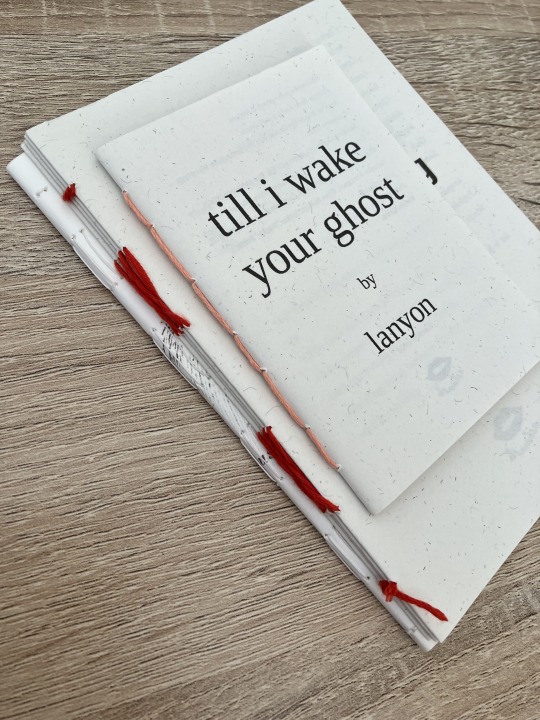
pamphlet stitch (uneven number of holes) I haven't ever done a pamphlet stitch but here's a tutorial for how to do it: https://www.starpointestudio.com/simple-pamphlet-stitch-book-step-by-step/
saddle stitch (uneven number of holes) I realised that what I was thinking of as a pamphlet stitch is actually saddle stitch, as in this A7 pamphlet:
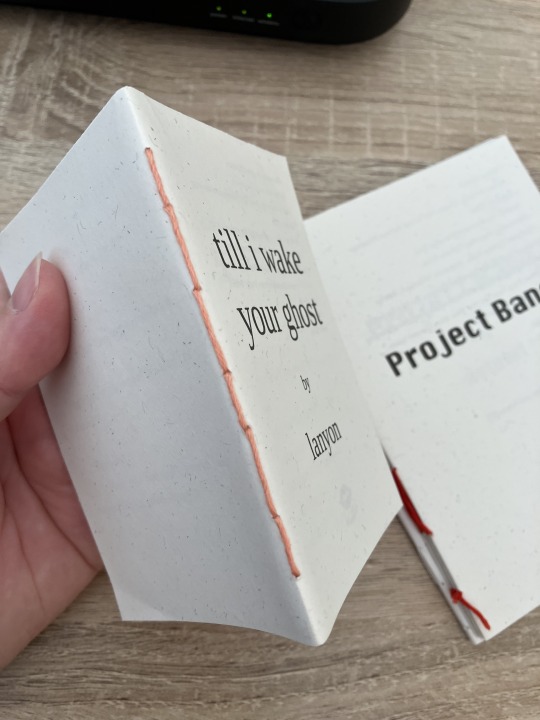
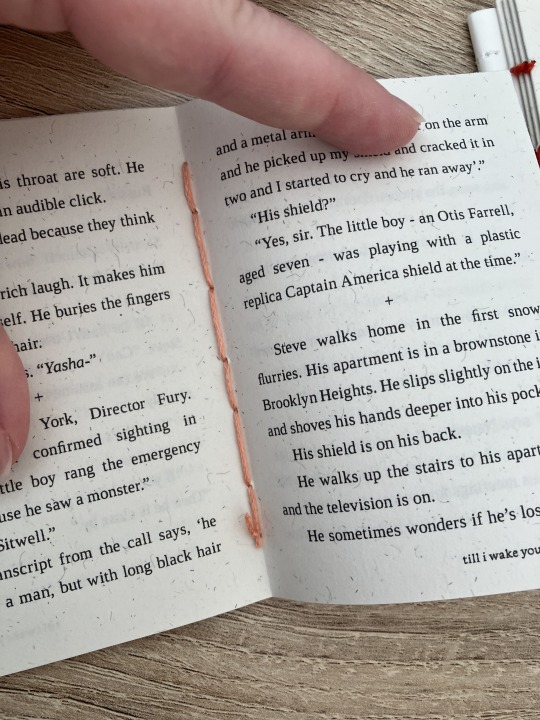
here's a tutorial for how to sew saddle stitch: https://www.bookbindingworkshopsg.com/saddle-stitch-bookbinding-tutorial/ here's a video tutorial: https://www.youtube.com/watch?v=aWHkY5jOoqM (sealemon has a lot of bookbinding tutorials and I know many people who like her videos, I used her tutorial for coptic binding way back when I first made a book but I can't otherwise vouch for the quality as I haven't used her videos)
french link stitch (even number of holes) in this one I used french link stitch which I typically use for thicker textblocks that i'm not planning to use tapes with as the french link gives it some robustness, I used it here because I had never done it before and wanted to try it out. I am planning to take these stitches out and re-sew this pamphlet with a cover now that I've found a suitable piece of transformer fanart to use as a cover:
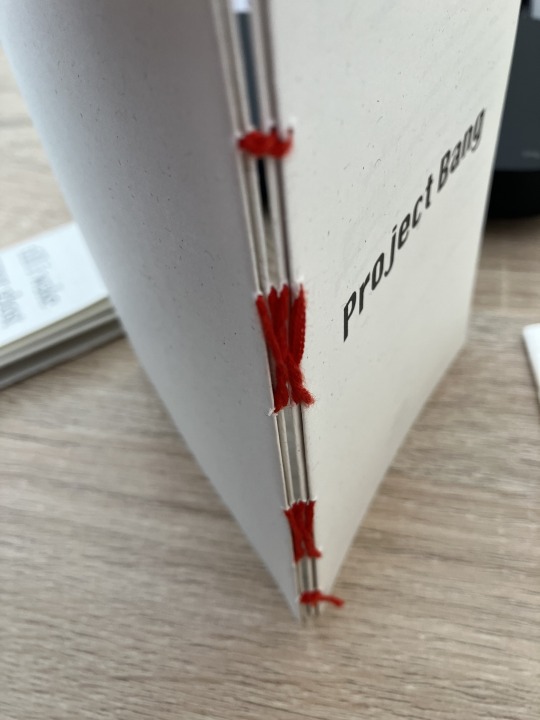
french link tutorial. it's quite long but it has a colour coded bit towards the end that shows how the thread is supposed to link which i find very helpful to visualise: https://www.handmadebooksandjournals.com/bindings/french-link-stitch-binding/
here's a video tutoral from DAS bookbinding (he is my go to for techniques and he has the most soothing Australian accent as well, though fair warning not all of his videos are for beginners): https://www.youtube.com/watch?v=O4ZPdbaM-Ws
long stitch (even number of holes) for this one I used long stitch and I had a cover. this one is my favourite variation because I can make these pretty and simple covers and the stitch looks nice on the outside as well, so this one scratches the 'i want to make a book' itch for me.
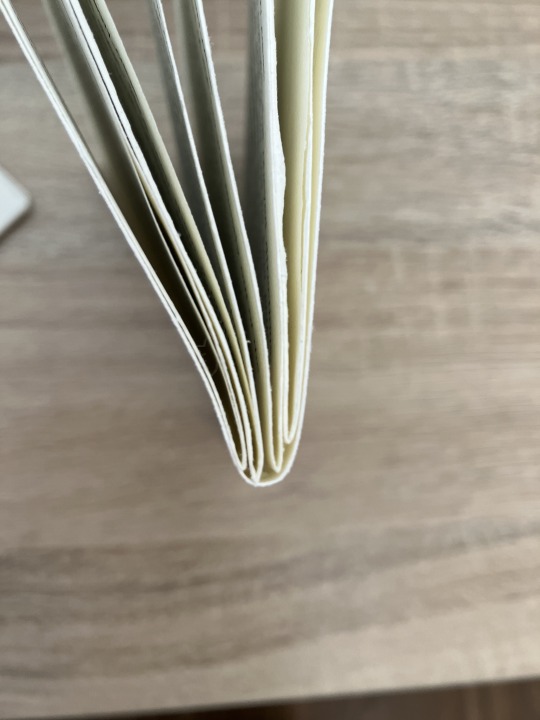
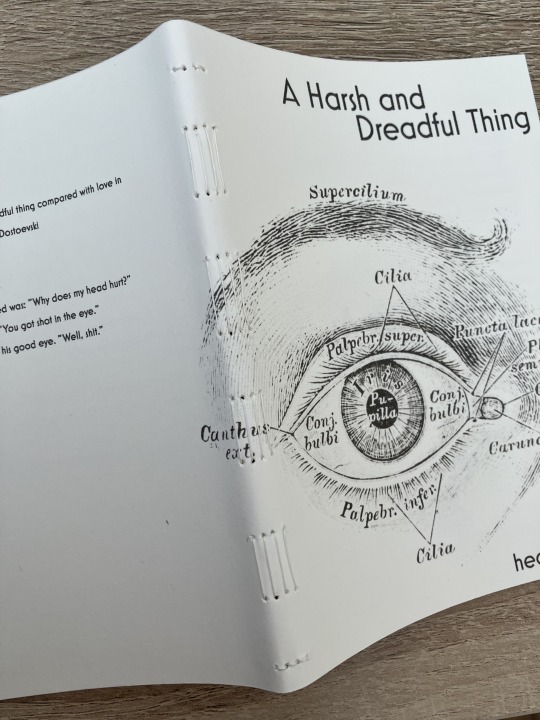
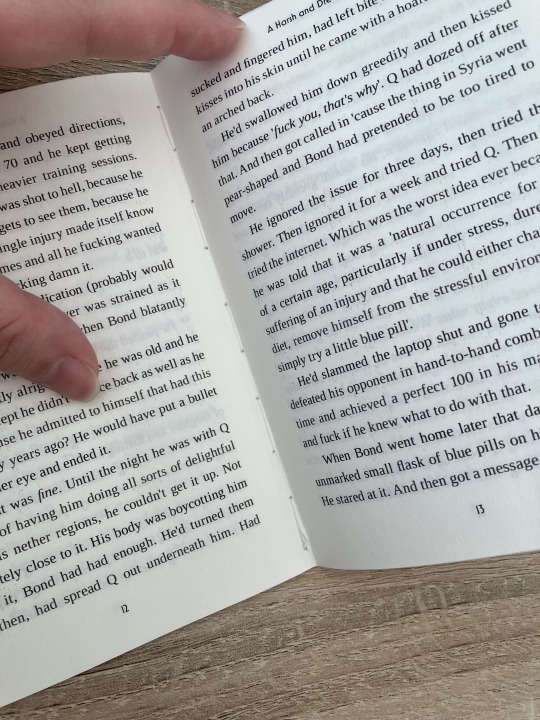
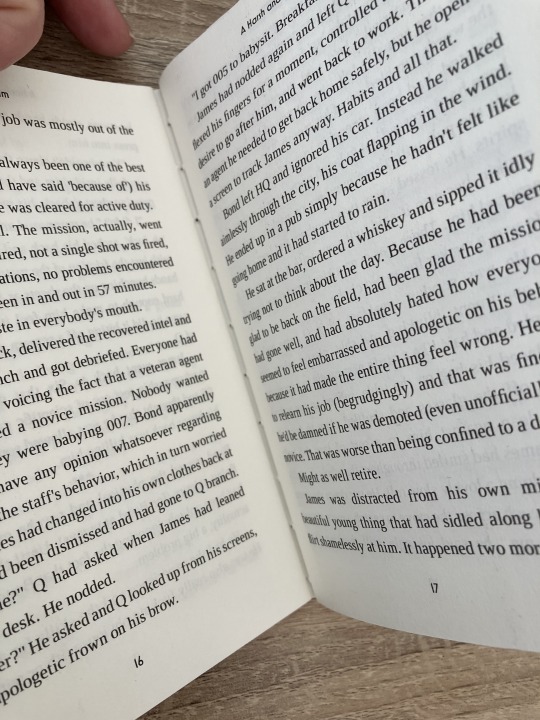
here's a tutorial that also includes a how to on a cover that is different from my cover: https://lccprintmaking.myblog.arts.ac.uk/files/2020/06/Long-Stitch-Tutorial-A4.pdf DAS also has a video tutorial for long stitch but it's like three videos long, maybe watch it later :'D here's one I haven't watched but seems decent: https://www.youtube.com/watch?v=XnignTL_wDQ
you can use saddle stitch for this kind of pamphlet as well, that's what I did for dozens of ships and hundreds of souls (https://ashmouthbooks.tumblr.com/post/681587080267202560).
I hope this helped!!
2K notes
·
View notes
Text
Ernie Gygax (Ernest Gary Gygax Jr), oldest son of Gary Gygax, has died. A highly polarizing figure in later life, he contributed to D&D's very early history by playing the character Tenser in home games and receiving credit as a playtester or occasionally coauthor when his father incorporated his ideas into publications. He also ran TSR's Dungeon Hobby Shop in Lake Geneva, WI, introducing many new customers to the game with demo sessions exploring his Hobby Shop Dungeon.
In 2012 he co-founded a new "TSR" with younger brother Luke and a diverse group of contributors including many familiar names from the AD&D days. Their Gygax Magazine produced 6 issues, ending after Gary's widow Gail sued the group for infringing copyrights and using the family name.
A 2015 Kickstarter for a published version of Ernie's Hobby Shop Dungeon titled Marmoreal Tomb went unfulfilled for many years before being turned over to Troll Lord Games for completion.
For many his legacy will be the convoluted, nasty history of "NuTSR" which directly led to a more sharply divided gaming community. These events were documented in detail by those who watched it unfold, including this thorough summary of events on EN World.
According to numerous accounts, Ernie was prominently involved in forming a third "TSR" in 2021 which claimed to be a continuation of the original company and attempted to license the TSR name to others and publish a new version of Star Frontiers. This venture split apart under legal pressure from other former members of the 2nd TSR and from WOTC which claimed IP infringement on the original Star Frontiers game which was still for sale as PDFs. The group also generated a storm of self-inflicted bad publicity through a series of bigoted anti "woke" social media posts and leaked product documents with overtly racist content. In interviews Ernie stood by the group's public positions, claiming their "playing style" was under attack by politically motivated persons. Major conventions quickly rejected the group, and Luke Gygax and many other TSR2 and OSR creators publicly repudiated TSR3's statements and spurious legal claims.
#and with any luck I won't have to revisit NuTSR ever again#Ernie Gygax#OSR#TSR#NuTSR#gaming history
81 notes
·
View notes
Text
VAST Guides are here!
By using VAST, you can learn how to add accessibility tags for screen readers to your PDFs, by using Adobe InDesign and Adobe Acrobat.
I'm super excited to release a brand new publishing community resource: VAST (or Visual Accessibility Skills Toolkit).
>> WWW.VAST.GUIDE <<
VAST is a collection of short articles aiming to spread awareness about what visual impairments are, and how folks in the small press industry can accommodate them.
The guides are split into four sections:
Visual Impairment 101 explores what visual impairments are, how visually impaired people navigate digital content, and introduces some current language and definitions (circa 2023).
Screen reading PDFs explores the basics of how screen readers navigate through digital content. Includes video examples!
Using InDesign introduces different tools that designers can use to make their documents more accessible.
Putting Into Practice presents case studies of common structures in roleplaying games, and how they could be given accessibility tags using tools covered in section 3. (Coming soon!)
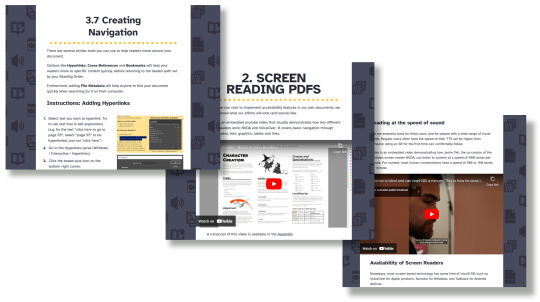
VAST was developed by Brian Tyrrell (me!), and disability advocate and accessibility consultant Yubi Coates. Visually impaired consultants and InDesign experts were brought in to corroborate the guides.
All of the information in the guides is up to date, and we’re committed to reviewing and updating the guides in 2024 and 2025.
This project was completed using a small pot of funding provided by Creative Scotland’s Create: Inclusion program in 2022.
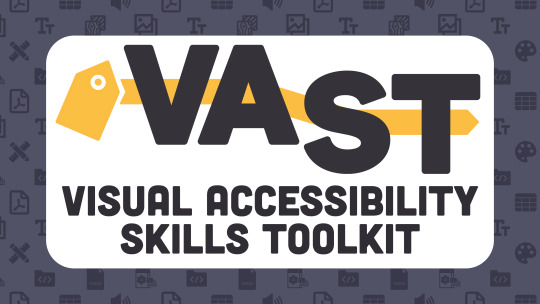
#ttrpg design#indie ttrpg#tabletop rpg#publishing#visual accessibility#screen reader#visually impaired#blindness#accessibility#pdf#indesign#acrobat#adobe#free resources#I always get anxious when releasing stuff#brb going to sit in a corner now#hope you like it!
527 notes
·
View notes
Text

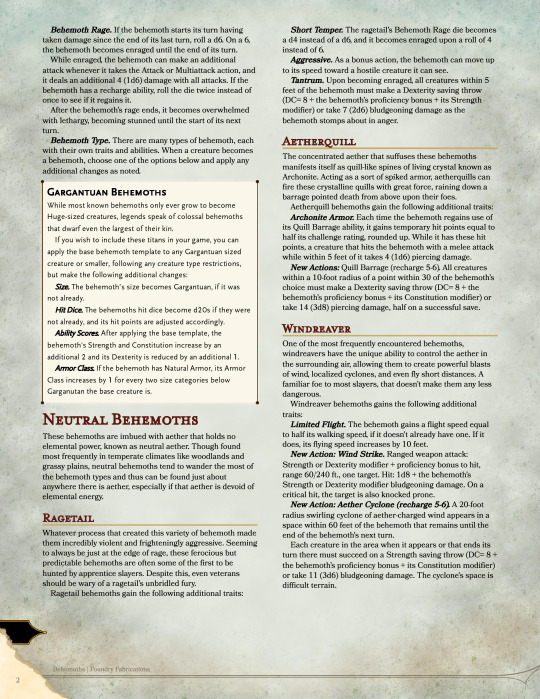


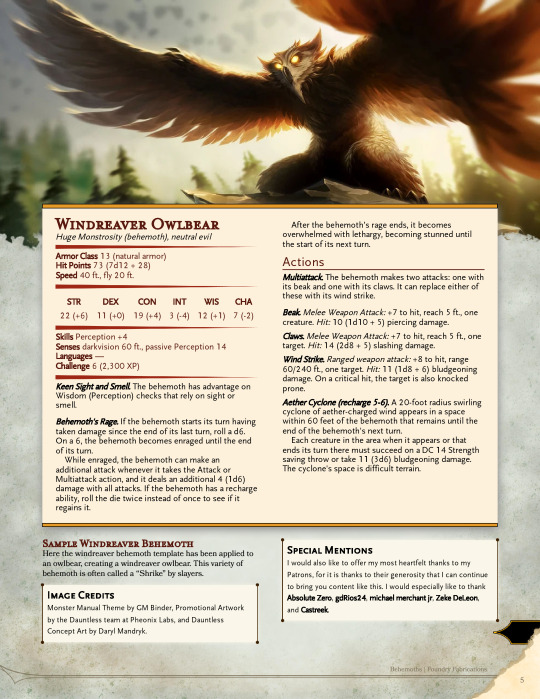
Hey folks! It took WAY too long to get this out, but it's finally done. Well, technically it isn't done, but I'll get to that in a bit. One weird thing that needs explanation at a time.
So, as one can tell, I didn't just make statblocks for the behemoths, write some lore, and call it a day. I've discovered that I really don't like making statblocks and dealing with all the nonsense that comes with it (CR is a joke, and I'm not laughing). So, in typical Foundry fashion, I tried doing something weird that requires more work and ultimately still required me to make statblocks anyway. Yeah, I'm not smart.
So I made them templates instead. And while I was tempted to give up and just do the obvious thing since I was just going to end up with stats anyway, making them templates makes a certain amount of sense from a lore perspective and I genuinely think is an interesting idea worth pursuing. Quick lore tidbit, behemoths are likely the result of normal creatures becoming mutated by aether (it's not certain, but there are signs of this origin from what I've read), so a template makes logical sense. So, as long as I pick appropriate creatures for the template examples, the end result will get you pretty close to the behemoths in game. Sure, they're not perfect, but it would be easy to tweak them to better suit your game.
So the other behemoth in the room is there are only 3 behemoths here. I had intended on releasing them all at once. Turns out there's like 30+ behemoths AND 5 basically legendary behemoths. So, I'm splitting them up into their elemental categories, and the legendaries by themselves. I already have the Blaze behemoths written out, so those won't take nearly as long. As I complete each category, I'll update this post and make y'all aware of the additions. By the end, I'll have one document with all of them in it, a brew to rival Flesh & Bone.
But for now, a quick break to work on something else my ADHD has compelled me to rework. Stay tuned for that. Anyway, stay safe, don't forget to love each other, and I'll see you next time.
Enjoy my work? Consider leaving me a Tip or supporting me on Patreon! Patrons gain access to high quality PDFs for all of my content, weekly updates, early access, and more!
#dungeons and dragons#5th edition#dnd#conversion#homebrew#5e#dnd 5e homebrew#5e dnd#dnd homebrew#dauntless#slayer#magical items#phoenix labs#monsters#behemoth#giant monsters#kaiju#aether#wotc#wizards of the coast#tabletop#Tabletop Games#Tabletop RPG#tabletop roleplaying#ttrpg
138 notes
·
View notes
Note
Love your work!
Do you have a ko-fi or similar place where people can support you?
Seeing as Tumblr has mostly died out, I will probably start posting there instead. Don't have any content there yet but I will try to start keeping up with this blog again and hopefully satisfy some older requests... hopefully the campaigns those were meant for are still going.
https://ko-fi.com/thirdtofifth
I will try to keep updating here now and then, as well as changing my formatting for the posts, and probably consolidating what I have into a homebrewery link or some kind of larger, more usable document (especially that can be downloaded to PDF and printed). I have HUNDREDS of monsters in various states of completion. My efforts have mostly moved to homebrew, but that's a separate project, which has let me stretch the boundaries of D&D 5e's monster-making parameters.
And with a new 2024 version of the rules to adjust to, with a new stat block, things are a bit odd. I liked the standardization of 5e, but now it seems to be split across two versions of the rules, which takes away a bit from that.
But I do intend to revive this, and possibly turn it into a YouTube channel as well to make it a bit more entertaining, as well as go into my process for converting monsters, which I have honed (on and off at least) for the better part of a decade now.
Thank you for all the follows and notes! More monsters to come!
17 notes
·
View notes
Note
Hello. You probably know how sysmeds say that DID can only be formed in childhood and that this is science. One person in a plural community have found and shared a scientific paper that disproves this, so I think it is my duty to share it with you as it addresses a very important question about how trauma doesn't need to happen in childhood. It is written by Duk Moon and is called «Unveiling the complexity of dissociative identity disorder of an adolescent». It states:
«Childhood adversity and abuse often leads to the development of dissociative identity disorder, but not exclusively.
Dissociative Identity Disorder (DID) is a member of the family of dissociative disorders classified by the DSM-IV, DSM-V-TR, ICD 10, ICD 11, and Merck manual. There are sources claiming DID can't form after childhood, and that Dissociative identity disorder is childhood trauma exclusive but there is disagreement about that.
The DSM, ICD and Merck manual do not state that dissociative identity disorder is trauma exclusive or childhood trauma exclusive. DID does commonly arises due to childhood trauma but not exclusively. "The disorder may begin at any age, from early childhood to late life." Merck manual.
Dissociative identity disorder can arise from many reasons that are not as common as childhood trauma. Other extreme complex traumas such as combat in wars or attachment disturbance, natural disaster, adversity, cult and occult abuse, loss of a loved one or loved ones, human trafficking, extreme medical diagnoses (e.g. rare brain cancers, arachnoid cysts, temporal lobe epilepsy and geschwind syndrome, traumatic brain injury) or surgeries, extreme family conditions, and a combination of traumas could all cause an already fragile mind to split into multiple personality states. "Some patients have not been abused but have experienced an important early loss (such as death of a parent), serious medical illness, or other overwhelmingly stressful events."- Merck manual»
Here's a pdf:
https://www.aseanjournalofpsychiatry.org/articles/unveiling-the-complexity-of-dissociative-identity-disorder-of-an-adolescent.pdf
It seems that checking the Merck manual would also be a great idea.
Moreover other people also shared very helpful resources too. I think it would be great to add this all to endogenic syscourse primer somehow.:
https://www.psychologytoday.com/sites/default/files/Possession%20and%20DSM%205.pdf
https://drive.google.com/file/d/14LE2m2BhNzBz6JWjSXNxAkqSrB7UzPue/view
https://drive.google.com/file/d/1hcMLBTc41yu8PXL_oW4MieSwlLxPCPT3/view
https://pubs.sciepub.com/rpbs/5/2/1/index.html#:~:text=Tulpamancy%20is%20a%20collection%20of,conscious%20entities%20within%20the%20mind.&text=Tulpas%20are%20an%20experience%20of,,%20happiness,%20and%20mental%20health
https://docs.google.com/document/d/1_5iSiTjqlyCjd3krzQwjAMbZOQzKKpbcmRI0NsHfPpA/edit
As well as a document listing a big amount of sources on non-traumagenic and endogenic plurality:
https://docs.google.com/document/d/1_5iSiTjqlyCjd3krzQwjAMbZOQzKKpbcmRI0NsHfPpA/edit
I'm sorry if you knew about some or all of this already, but I hope I provided something new for the syscourse.
Thanks for all the links and sources! These are great!
I will say that there are a few things about the quoted article that would make me hesitant to use this as a source of endogenic DID.
The quotes from the Merck Manual it cites seem to imply DID is still being caused by overwhelming negative experiences, which most people would still classify as being traumatic. It doesn't cite sources of its own even when it should be. And it seems to misunderstand the line about DID developing at any point in life.
My understanding about that line isn't that it means the trauma that causes it happens at any point in life, but that it's when the onset of symptoms kicks in, which can be years after the trauma.
I would worry that an educated sysmed could tear into this pretty hard if given the chance. (Luckily, "educated sysmeds" seem to be an endangered species.)
Still, it's a really interesting find that I hadn't seen before! 😁👍
9 notes
·
View notes
Text
RETURN OF THE BOOK
Welp I did say in the original posts on this blog that life might get in the way of this project and BOY HOWDY did life get in the way. I can't even remember the last post I made on this blog.
But I'm coming back with some excellent news. The edited text of Sansukh is now complete! That's right, I've finished spell checking, formatting, footnoting, and arranging Sansukh into three books. And these files are available for anyone, for free! What can you do with these files? Whatever you want! Download them onto your e-reader, print them in your school's computer lab, or send them away to be printed as physical books. The choice is yours!
What you will find in the linked folder below is both pdfs and word documents of the original text of Sansukh split into three books. Each book contains a glossary of terms and a notes section at the end. There is also a separate document for the appendix stories Tasâlalkhud and A New Coat. I would add these to the end of the third book document, but I left them as their own document for anyone who doesn't wish to include them.
Thanks to everyone who followed along on this journey. It was a lot of work, but it was very rewarding and I am thrilled to have a final product to share. Life is continuing to be A Lot, but if I ever get a break, I will come back to this blog and document my work on getting these documents professionally printed for my own collection. I'd also love to see any physical copies y'all come up with! I hope you all enjoy this labor of love and are inspired to work on similar projects for your own favorite fics.
-Farewell for now, your faithful editor Em
33 notes
·
View notes
Text
A Guide to La Fayette’s Papers: Paris Archives
The Paris Archives are a true treasure trove for all sort of things and since so many liked the guide to the Archives of Seine-et-Marne, I wanted to give a little tour of the Paris Archives for everyone who might need it. I will be focusing on the official documents like certificate of birth, marriage and death.
So first, we go to the webpage of the Paris Archives.

Next, we go to the section Archives Numérisées.

Once there you can actually access the Paris Archives own guide further down on the page.

But we are mainly here for the État civil de Paris, the very first box on the page.

We are scrolling down to the end of the page and now need to know what we are even looking for. If we are looking for an event (birth, marriage or death) that happened up until 1859, we have to choose the État civil reconstitué (XVIe-1859). For everything else, the État civil à partir de 1860 is just the thing for us. Most documents that are relevant for La Fayette and his immediate family are to be found in the État civil reconstitué (XVIe-1859).

Onwards we move and can now choose between the Fichiers de l'état civil reconstitué or the Actes de l'état civil reconstitué. The Fichiers are basically the short, alphabetically sorted version of the Actes and in my opinion much easier to search, especially if we do not know exactly what we are looking for. They are also only one page and present only the most basic information in short without much detail. We start with the Fichiers here.

We can now enter the type of document we are looking for (death, marriage and birth, displayed in that order) and the name of the person we are looking for. Now, here is the reminder that La Fayette was the families title, the surname was du Motier – depending on the archive we are using, sometimes both title or surname will yield results, sometimes just the one or the other and sometimes you even need a very specific spelling. In the case of the Paris Archives, I found that Dumottier works best – but I encourage you to always do some fiddling.
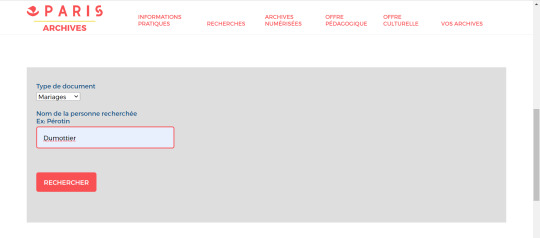
As you might have already guessed, we are looking for the certificate of marriage for Adrienne and La Fayette. These are our results:
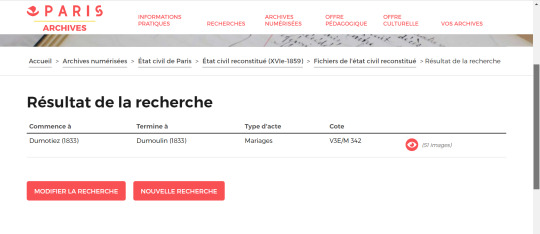
With a click on the “eye” we can access the documents. They are indexed alphabetically and the first and last name found within the file is listed. If a name appears more than once, they are sorted by date.
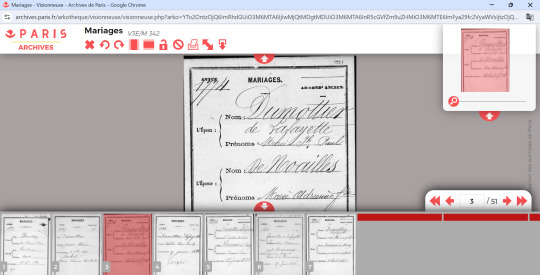
As we can see, Fichiers only display the most important information, but they are easy to search … and look, the third entry is the certificate of Adrienne’s and La Fayette’s marriage that we were looking for. Now, the great thing about Fichiers is that they are sorted by name. Therefor, on pages four to seven we find the marriage certificates of Adrienne’s and La Fayette’s grandchildren.
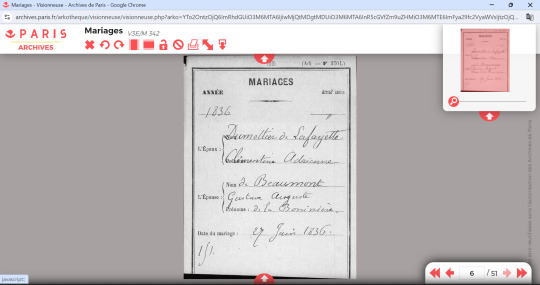
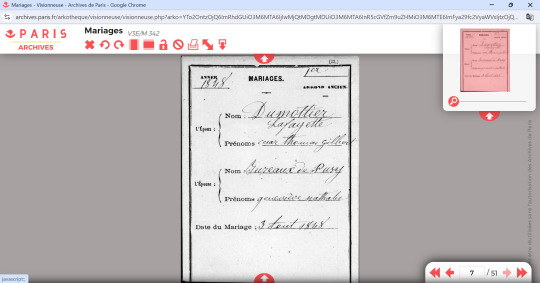
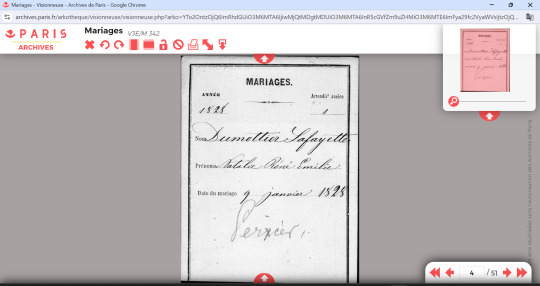

With the symbol on the very right in the header we can download our finds as a PDF.

I really like that the Paris Archives mark which files have already been looked at by us.

Now lets us have a look what happens when we choose the Actes and not the Fichiers.

We can again choose the type of document but search for a date now and not a name. The more precise we are, the better, since this happens, if we only know the year an event took place.
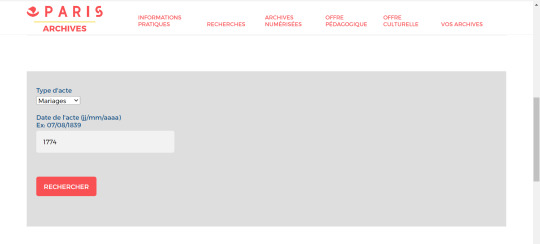
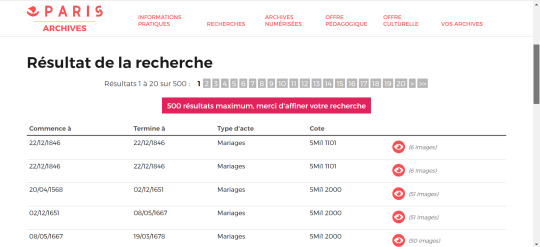
Now, with an exact date (a date we knew from the Fichiers) we find this:
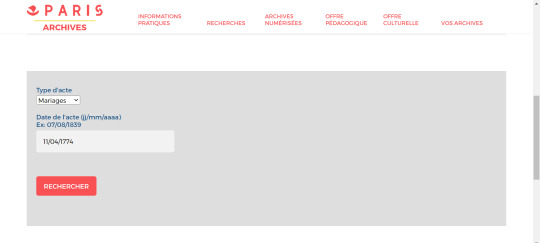
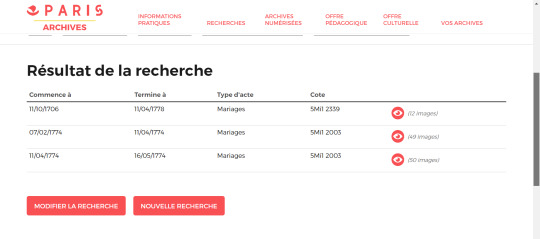
I know that the La Fayette’s marriage certificate is split over both pf the two 5Mil 2003 files.
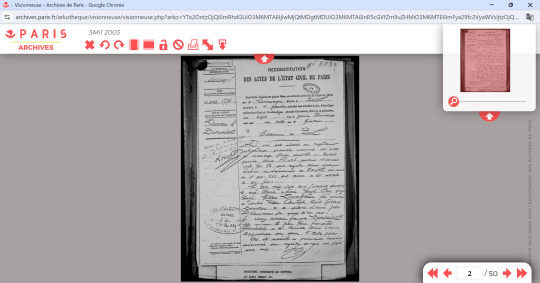
Et Voila! Happy researching!
#marquis de lafayette#la fayette#lafayette#french history#american history#history#archieve#paris archieves#resources#a guide to the lafayette papers
17 notes
·
View notes
Note
Hello! I am just starting my journey on reconnecting with my traditional roots as an Italian practitioner. My great grandparents came from Italy in the mid 1900s, but unfortunately passed before I had the pleasure of asking about their practices. Can I ask a good starting point for someone who is trying to reconnect all on her own?
Hello!
I am so happy that you are wanting to reconnect with your roots! I'm sorry you didn't get the opportunity to ask your grandparents, my deepest condolences for your loss.
In terms of resources, my recommendation for anyone starting out is to go to folklore sources or to read books by authors who don't simply reference other witchcraft authors. I highly recommend reading Italian Folk Magic: Rue's Kitchen Witchery by Mary-Grace Fahrun. It's mostly her personal experience with Italian folk-Catholicism and magic with plenty of anecdotes, recipes, superstitions, and various rituals. I think it's probably the best widely available source out there. She also has a youtube channel! In a similar vein, the website Italian Folk Magic has some great posts about Southern Italian and Sicilian magic.
Other online resources I've found useful are Gail Faith Edwards' writings on Southern Italian healers and folk medicine (it's split into 2 parts–– there's a lot of great information if you're into herbalism/ green witchcraft). I also love this article detailing witchcraft history, superstition, and more throughout Italy. It goes into a lot of detail and has some information about herbal properties and their uses as well.
Here are some festivals and traditions from across Italy tied to folk belief: Focara of Novoli, The Campanacci in Basilicata, The Feast of San Domenico and the Ritual of Serpari of Cocullo, Naca Procession in Southern Italy, Dance of the Devils, Celebration of Santa Lucia, The Feast of Mamma Schiavona––There are many others (mostly Saint feasts) that have pre-Christian roots or have significant rituals attached.
Most information that I have collected comes from anthropological and folklore sources that aren't very accessible. There are some videos available of documentary footage of Italian anthropologist Ernesto de Martino's work detailing folk tradition: here's a clip of La Taranta. This documentary isn't in English, however you can still get a lot out of it even if you don't speak Italian (unfortunately there are no subtitles). The documentarian that worked with de Martino, Luigi Di Gianni gives some of his recollections here. Here is a clip documenting the Feast of Mamma Schiavona. Otherwise, everything else is behind a paywall on sites like jstor, sagepub, and other academic publishers. I would recommend reading anything by anthropologist and folklorist Sabina Magliocco (I have copies of her work), as well as de Martino's Magic: A Theory from the South (which I also have a pdf of). The academic texts can be a little dense and daunting, but they're worth the read.
I have uploaded some of what I have to WeTransfer, but it will only be up for 1 week (until July 10th) so if anyone else would like to download them, you can for a limited time!
#italian folk magic#folk magic#folk traditions#witchcraft#beginner witch#baby witch#witchblr#italian witchcraft#grimoire#book of shadows#streghe#stregoneria#benedicaria#witch tips#long post#witches of tumblr
127 notes
·
View notes